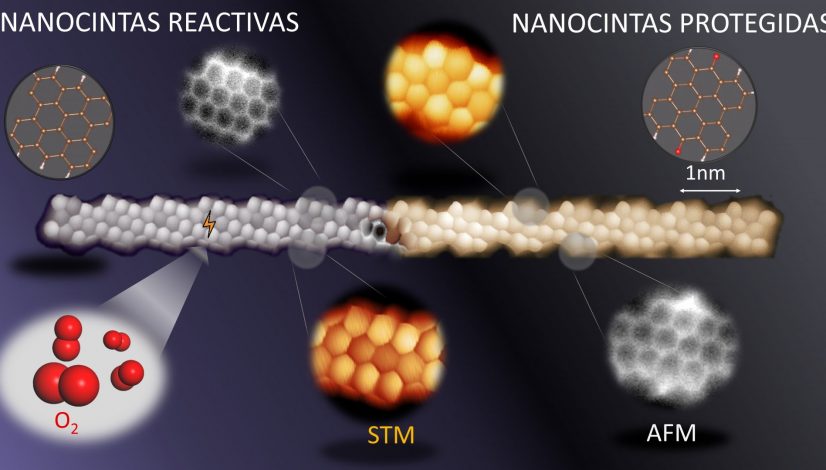An international team with participation of CINN implements protection/deprotection strategies for the on-surface synthesis of technologically prominent graphene nanostructures
The work has just been published in the journal Nature Chemistry
In the last decades, a new synthetic approach has been developed, generally termed as “on-surface synthesis” that substantially departs from standard wet-chemistry. Instead of the three-dimensional space of solvents in the latter, the environment of the reactants in this new approach are well-defined two-dimensional solid surfaces that are typically held under vacuum conditions. These differences have allowed the successful synthesis of a great variety of molecular structures that could not be obtained by conventional means. Among the structures that are raising particular interest, we find carbon-nanostructures with zigzag-shaped edges, which endow the materials with exciting electronic and even magnetic properties of potential interest for a great variety of applications that include quantum technologies.
An important downside of these materials, however, is that they often lack sufficient chemical stability to withstand air exposure. That is why environments like vacuum are used to make the synthesis possible. Unfortunately, for their ultimate implementation in actual devices, these structures need to be manipulated and transferred out of the vacuum, which would degrade the materials and therefore jeopardize their potential utilization. This brings up the need to conceive new strategies for the device fabrication processes.
Protection/deprotection strategies of nanostructures
In conventional chemistry, protection/deprotection strategies are commonly applied to overcome stability problems. However, it remained to be tested whether such protection chemistry strategies could also be applied in “on-surface synthesis”.
In this work, an international team from DIPC y CFM (CSIC-UPV/EHU) en San Sebastián, CIQUS – Universidade de Santiago de Compostela, Academia Checa de Ciencias (Praga), Universidad Palacký (Olomouc), Ikerbasque (País Vasco) y CINN (CSIC-UNIOVI-PA) de El Entrego, realizó dichas pruebas con nanocintas de grafeno provistas de una gran densidad de bordes en zigzag.
El trabajo presenta dos métodos relacionados pero complementarios para aplicar la estrategia de protección/desprotección a los segmentos de borde en zigzag reactivos de nanografenos.
En concreto, han demostrado que es posible emplear hidrógeno atómico para proteger el grafeno nanoestructurado de los efectos oxidantes de la atmósfera y, posteriormente, convertir fácilmente estas nanoestructuras a su forma original mediante una deshidrogenación a través de un tratamiento de recocido. Un enfoque alternativo les permitió convertir una forma químicamente modificada y estable al aire de las nanoestructuras de grafeno, con grupos laterales cetónicos de protección, en las moléculas de interés.
A breakthrough towards the integration of carbon nanostructures into devices
The implications of these results are far reaching. The demonstrated protection/deprotection strategy is expected to be similarly applicable to graphene nanostructures with zigzag edge segments different from those probed here. It thus opens new doors for the conception of approaches to integrate carbon nanostructures into devices and may thereby bring the exploitation of the unique characteristics of their zigzag edges a step closer to scalable applications, a grand scientific challenge that cuts across physics, chemistry, materials science and engineering.

Reference
Circumventing the stability problems of graphene nanoribbon zigzag edges. James Lawrence, Alejandro Berdonces-Layunta, Shayan Edalatmanesh, Jesus Castro-Esteban, Tao Wang, Alejandro Jimenez-Martin, Bruno de la Torre, Rodrigo Castrillo-Bodero, Paula Angulo-Portugal, Mohammed S. G. Mohammed, Adam Matěj, Manuel Vilas-Varela, Frederik Schiller, Martina Corso, Pavel Jelinek, Diego Peña and Dimas G. de Oteyza. Nature Chemistry (2022) https://www.nature.com/articles/s41557-022-01042-8




